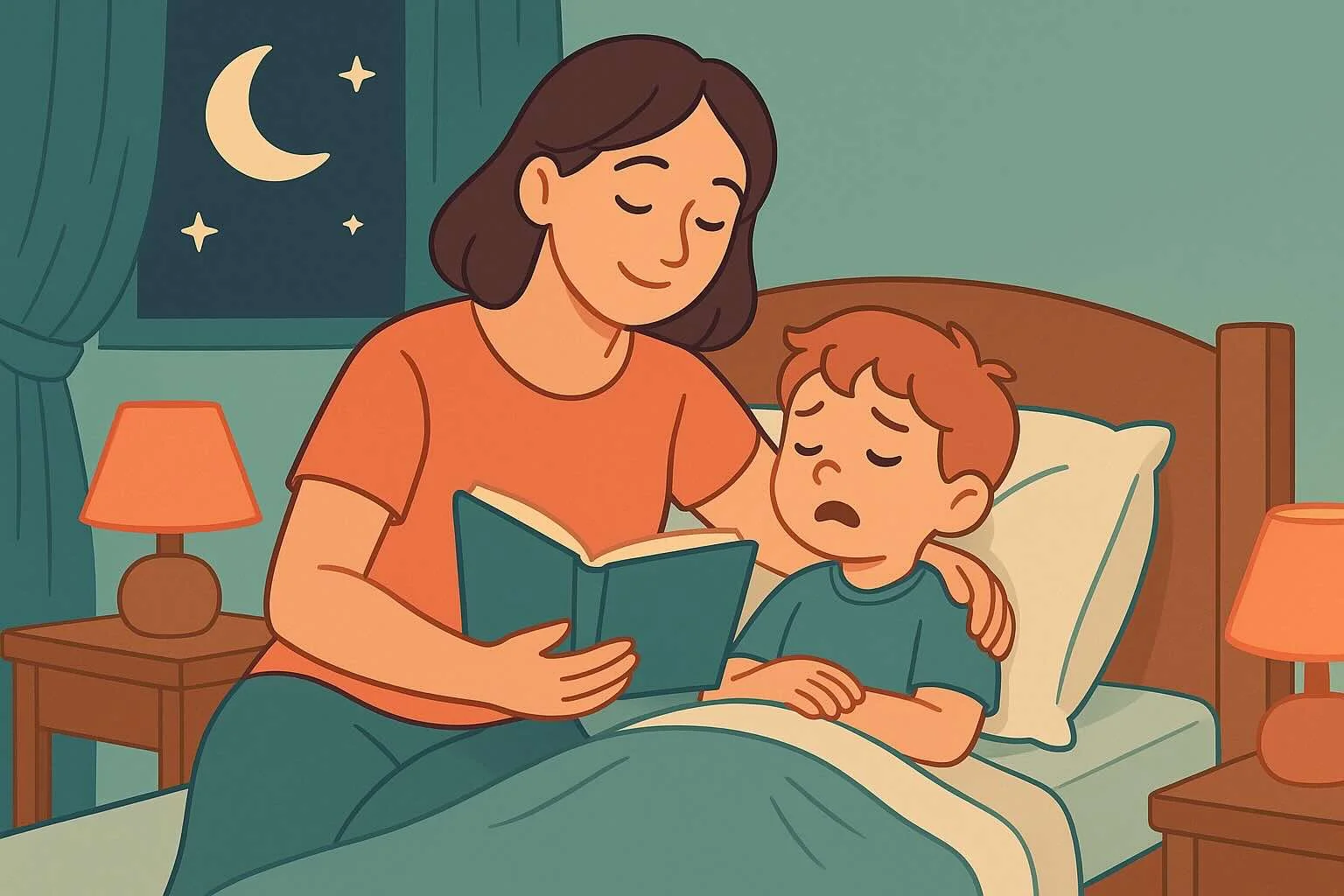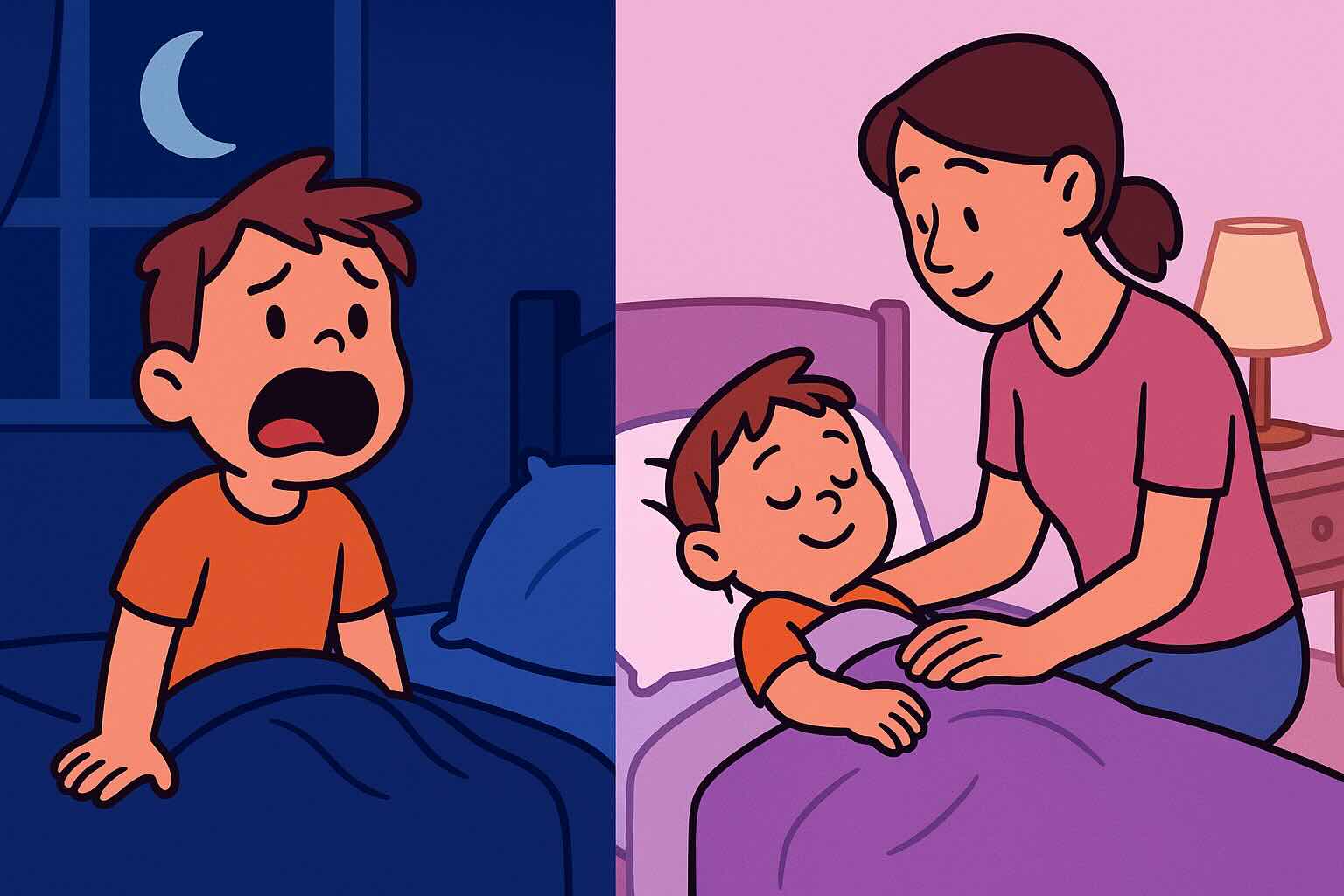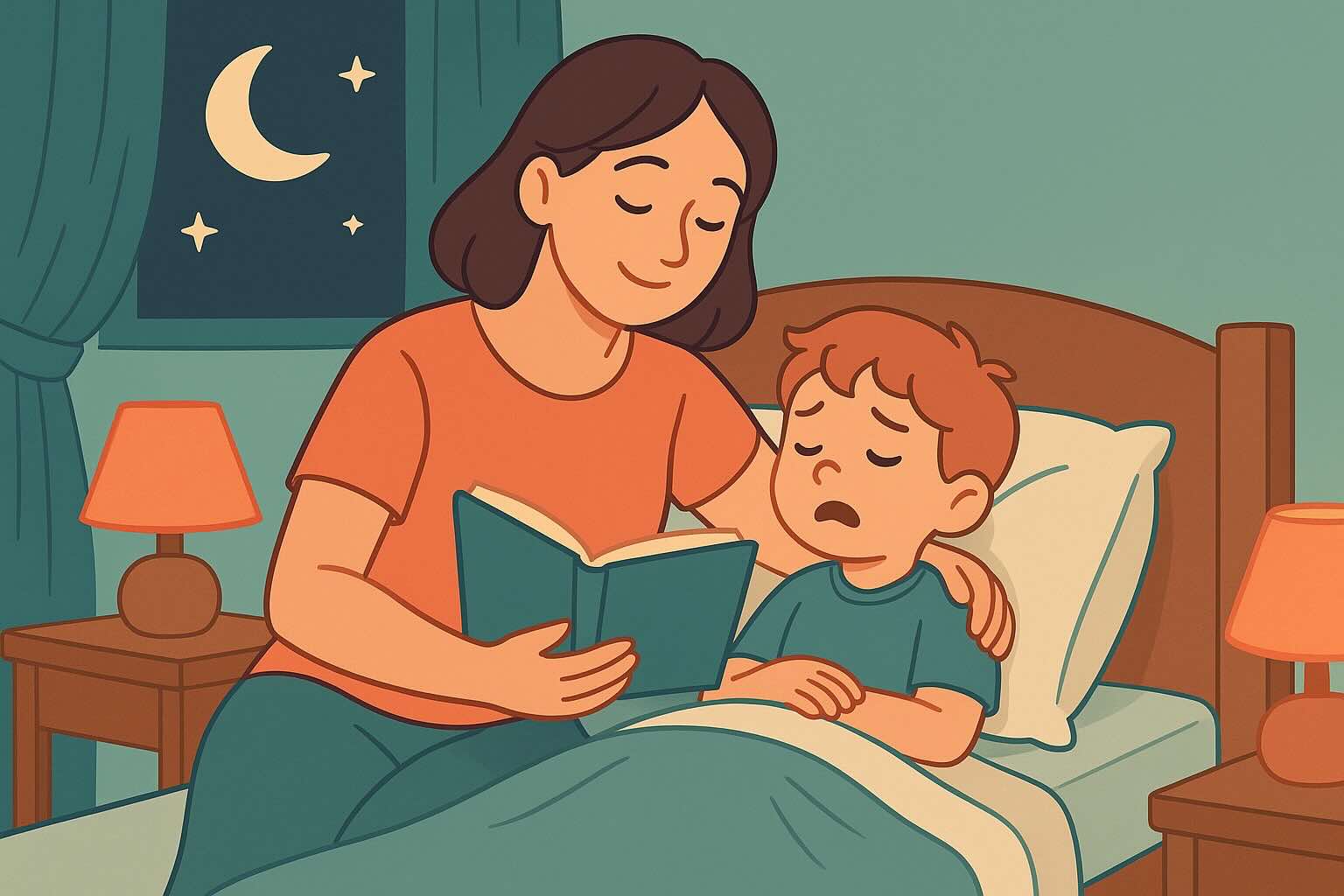Night Wakings and Sleep Disruptions: 8 Solutions

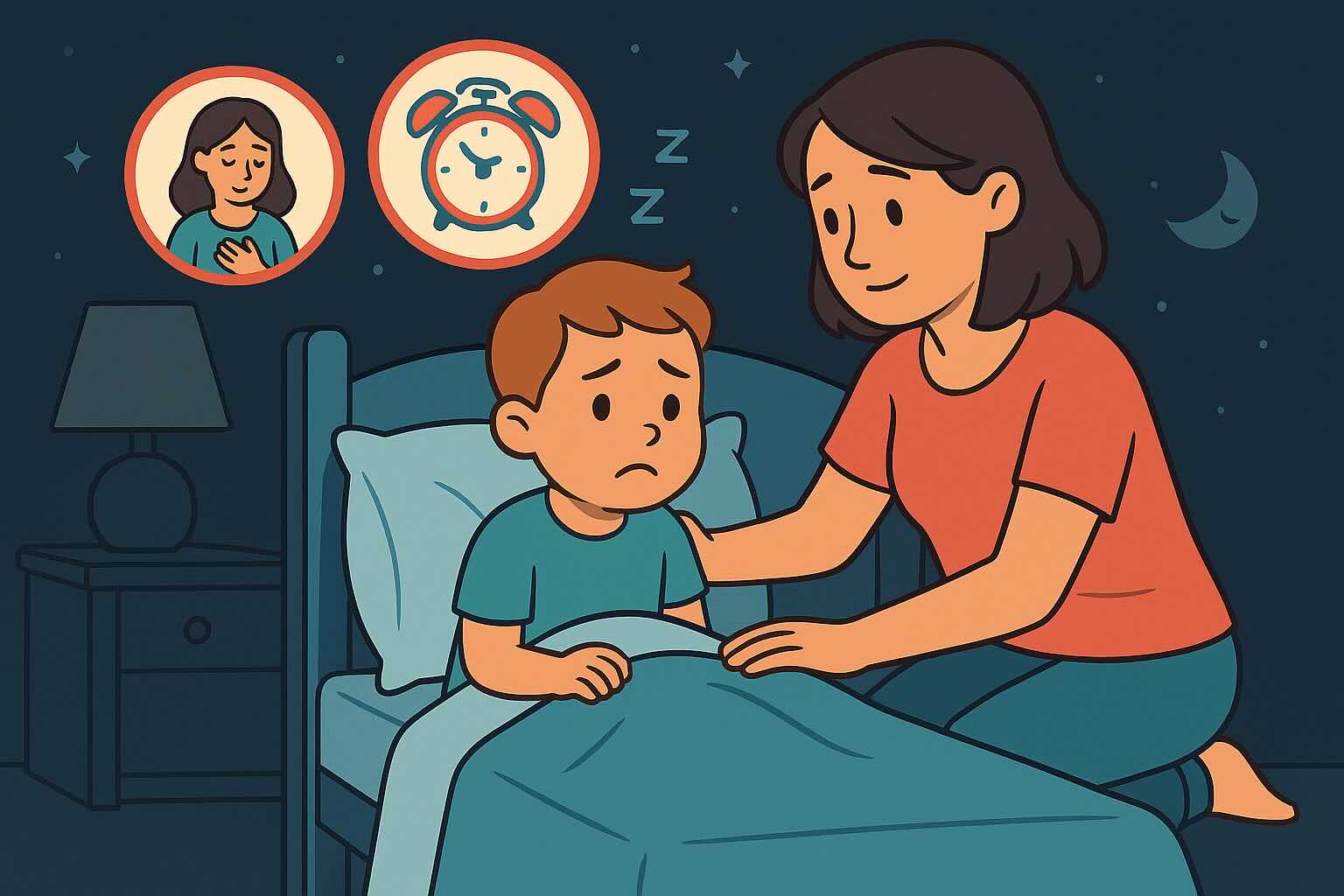
If your nights are punctuated by little footsteps padding to your room, cries of "Mommy!" at 2 AM, or a child who seems to wake up every few hours seeking comfort, you're experiencing one of the most exhausting challenges of parenting school-age children. Research shows that 35% of children ages 3-7 experience frequent night wakings, but here's the encouraging news: most families see dramatic improvement within 3-4 weeks using targeted strategies.
This comprehensive guide addresses the root causes of night wakings and provides evidence-based solutions that teach your child to navigate normal sleep cycles independently, creating better rest for the entire family.
What You'll Learn in This Guide
- Understanding Normal vs. Problematic Wakings - When to be concerned and when to take action
- Root Cause Analysis - Identifying why your child wakes and what maintains the pattern
- The Self-Soothing Method - Teaching independent return-to-sleep skills
- Environmental Optimization - Creating conditions that support uninterrupted sleep
- Response Strategies - Exactly how to handle different types of night wakings
- Special Situations - Solutions for nightmares, night terrors, and other disruptions
- Family Sleep Recovery - Rebuilding healthy sleep patterns for everyone
For complete sleep support, also explore our guides on ending bedtime battles, addressing bedtime fears, building healthy sleep habits, and transitioning to independent sleep. If nighttime fears are contributing to your child's wakings, our comprehensive nighttime fears guide provides specialized strategies for building bedtime courage.
Estimated reading time: 14 minutes
Understanding Night Wakings: Normal vs. Problematic Patterns
Normal Sleep Architecture for Ages 3-7
What happens during healthy sleep: All children (and adults) experience brief awakenings throughout the night as they cycle through different sleep stages. Normal sleep includes:
- 4-6 sleep cycles per night lasting 90-120 minutes each
- Brief awakenings between cycles (usually 30 seconds to 2 minutes)
- Automatic return to sleep without conscious awareness or parental intervention
- Deeper sleep periods alternating with lighter REM sleep
Age-specific sleep patterns:
- Ages 3-4: May still experience 1-2 brief conscious awakenings
- Ages 5-7: Should typically sleep through the night without parental assistance
- All ages: May wake during illness, stress, or environmental disruptions
Problematic Night Waking Patterns
Concerning patterns include:
- Frequent conscious wakings (more than once per night regularly)
- Inability to return to sleep independently after waking
- Extended wake periods lasting 20+ minutes in the middle of the night
- Seeking parental intervention for comfort or help falling back asleep
- Emotional distress associated with night wakings
- Daytime impact from poor sleep quality
Red flags requiring pediatric consultation:
- Night wakings with physical symptoms (fever, pain, breathing difficulties)
- Sudden onset of wakings after months of good sleep
- Extreme fear or panic associated with sleep
- Sleep walking or other concerning behaviors
- Wakings that worsen rather than improve over 4-6 weeks
Common Causes of Night Waking Patterns
Environmental factors:
- Room temperature too hot or cold
- Noise disruptions (traffic, household sounds, siblings)
- Light exposure from windows, electronics, or hallways
- Uncomfortable bedding or sleepwear
- Changes in familiar sleep environment
Physical factors:
- Overtiredness leading to restless sleep
- Hunger or thirst (especially during growth spurts)
- Uncomfortable sleeping position or movement during sleep
- Mild illness or allergies affecting comfort
- Bathroom needs
Emotional and developmental factors:
- Stress from family changes, school, or social situations
- Developmental leaps creating temporary sleep disruption
- Separation anxiety or bedtime fears
- Overstimulation from daytime activities or screen time
- Processing of significant experiences or learning
Learned behavioral patterns:
- History of parental response that inadvertently reinforced waking
- Habit patterns established during illness or stress
- Association between waking and receiving attention or comfort
- Lack of independent self-soothing skills
Root Cause Analysis: Identifying Your Child's Wake Pattern
Tracking and Assessment
Essential information to gather:
- Timing: What time(s) does your child typically wake?
- Duration: How long do wakings last?
- Behavior: What does your child do when they wake (cry, call out, come to your room)?
- Response: How do you currently respond?
- Resolution: What helps them return to sleep?
- Frequency: How many nights per week does this occur?
Sleep diary categories:
Environmental wake-ups:
- Consistent timing related to external noise sources
- Seasonal patterns (heating/cooling, daylight changes)
- Correlation with household activities
Physical need wake-ups:
- Bathroom trips
- Hunger or thirst
- Temperature discomfort
- Growth spurt patterns
Emotional/anxiety wake-ups:
- Calling for parent comfort
- Fear-based behaviors
- Difficulty returning to sleep without reassurance
- Connection to daytime stress or changes
Habit-based wake-ups:
- Consistent timing unrelated to external factors
- Automatic seeking of parental intervention
- Inability to self-soothe despite being physically comfortable
The Self-Soothing Method: Teaching Independent Sleep Skills
Understanding Self-Soothing Development
What self-soothing looks like for ages 3-7:
- Recognizing they've woken up briefly and don't need help
- Using comfort strategies independently (adjusting blankets, finding comfortable position)
- Employing calming techniques learned during bedtime routine
- Returning to sleep without parental intervention
Building blocks of self-soothing:
- Environmental familiarity - knowing their sleep space is safe
- Physical comfort skills - adjusting position, temperature, etc.
- Emotional regulation - managing brief anxiety or discomfort
- Cognitive strategies - using thoughts or mental images for comfort
Teaching Self-Soothing Skills
During calm, awake moments: Practice the skills your child can use when they wake at night:
Physical comfort strategies:
- "If you wake up and feel hot, you can kick off your blanket"
- "If you're cold, you can pull your covers up"
- "If your pillow feels funny, you can fluff it or turn it over"
- "If you need to change positions, you can roll over quietly"
Emotional comfort strategies:
- "If you wake up and feel worried, you can hug your stuffed animal"
- "You can think about me sleeping nearby and feel that love"
- "You can imagine your favorite peaceful place"
- "You can tell yourself: 'I'm safe, I'm loved, I can sleep'"
Cognitive strategies:
- "If your mind feels awake, you can count slowly or think about your breathing"
- "You can imagine floating on a cloud or swimming in warm water"
- "You can think about tomorrow's fun activities"
- "You can tell yourself: 'Everyone wakes up sometimes, and I can go back to sleep'"
The Graduated Response Protocol
When your child does wake and call for you, use this structured approach:
Level 1: Wait and Listen (1-3 minutes)
- Don't respond immediately unless there's obvious distress
- Many children return to sleep within 2-3 minutes if not interrupted
- Listen for escalation vs. settling patterns
Level 2: Verbal Reassurance (if needed)
- Respond from your room or hallway: "You're okay, time to sleep"
- Don't enter their room unless necessary
- Keep response brief and calm
- Wait 5-10 minutes before next response
Level 3: Brief In-Person Check (if crying continues)
- Enter room calmly without turning on lights
- Brief physical comfort (hand on back, brief hug)
- Minimal talking: "You're safe, time to sleep"
- Leave within 2-3 minutes
Level 4: Problem-Solving (for ongoing distress)
- Assess for legitimate needs (bathroom, water, comfort adjustment)
- Address practical needs briefly
- Return to sleep expectations immediately after
- Avoid extended comfort or conversation
Environmental Optimization for Uninterrupted Sleep
Temperature and Air Quality
Optimal sleep environment:
- Room temperature: 65-70°F (18-21°C) for most children
- Humidity levels: 30-50% relative humidity
- Air circulation: Gentle air movement without direct drafts
- Seasonal adjustments: Modify bedding rather than room temperature when possible
Temperature-related wake prevention:
- Layer bedding for easy adjustment during sleep
- Breathable sleepwear that wicks moisture
- Fan for air circulation in warmer months
- Space heater with timer for cold winter mornings
Light and Darkness Management
Promoting natural sleep cycles:
- Complete darkness for deep sleep phases
- Blackout curtains to prevent early morning light disruption
- Minimal night lighting - small red-light nightlight if needed
- No electronics in bedroom that emit blue light
Managing seasonal changes:
- Adjust bedtime slightly for daylight saving time
- Address early sunrise with blackout solutions
- Consider light therapy for winter sleep disruptions
Sound Environment
Noise management strategies:
- White noise machine to mask household and environmental sounds
- Consistent background sound throughout the night
- Addressing sibling noise with staggered bedtimes or separate rooms temporarily
- Household sound reduction during sleep hours
Comfort and Safety
Physical comfort optimization:
- Appropriate mattress firmness for child's size and preferences
- Quality pillows that support comfortable sleep position
- Breathable bedding that doesn't cause overheating
- Comfort objects readily available for self-soothing
Safety and security:
- Familiar sleep environment that doesn't change unexpectedly
- Safe access to bathroom with nightlight if needed
- Secure doors and windows so child feels protected
- Consistent family presence in nearby rooms
Response Strategies for Different Wake Types
The Comfort-Seeking Wake
Characteristics:
- Child calls for parent or comes to parent's room
- Seeking reassurance, hugs, or co-sleeping
- Often able to explain they want comfort
- May escalate if initial request is denied
Response strategy: "I hear that you want comfort. You can give yourself comfort with your [stuffed animal/blanket]. I believe you can do this."
Follow-up actions:
- Walk child back to their room if they've come to yours
- Brief reassurance without extended interaction
- Remind them of self-soothing tools
- Leave promptly and consistently
The Fear-Based Wake
Characteristics:
- Expressions of fear, worry, or "bad dreams"
- Difficulty returning to sleep due to anxiety
- May resist staying alone in room
- Often occurs during REM sleep periods
Response strategy: "I understand you feel scared. You are safe in your room. Let's use your brave skills."
Specific interventions:
- Brief validation without feeding the fear
- Remind them of coping strategies learned during bedtime
- Environmental check for legitimate concerns (sound, temperature)
- Gradual withdrawal of presence as they calm
The Practical Need Wake
Characteristics:
- Bathroom needs, thirst, or physical discomfort
- Usually quick to resolve once need is met
- Child may try to meet need independently first
- Less emotional distress, more matter-of-fact
Response strategy: Address the practical need efficiently without creating extended wake period.
Implementation:
- Quick bathroom trip with minimal interaction
- Provide water from bedside cup rather than trip to kitchen
- Adjust blankets or temperature quickly
- Return to sleep expectations immediately after need is met
The Habitual Wake
Characteristics:
- Occurs at consistent times unrelated to external factors
- Child seeks familiar comfort routine
- Often established during previous illness or stress period
- May escalate when familiar response isn't provided
Response strategy: "Your body woke up out of habit. It's time to practice going back to sleep on your own."
Breaking the pattern:
- Consistent, boring response that doesn't reinforce the habit
- Gradual reduction of interaction over 1-2 weeks
- Focus on self-soothing skill building
- Patience as new patterns establish
Special Situations: Nightmares, Night Terrors, and Other Disruptions
Nightmares vs. Night Terrors
Nightmares (REM sleep disruptions):
- Child is fully awake and responsive
- Can describe scary dream content
- Seeks comfort and reassurance
- Memory of the experience the next day
- Usually occurs in second half of night
Response to nightmares:
- Comfort briefly but don't dwell on dream content
- "Dreams can feel scary, but they're not real. You're safe now."
- Help them return to calm state
- Discuss dream content the next day, not during night waking
Night terrors (deep sleep disruptions):
- Child appears awake but is not responsive
- May scream, thrash, or seem panicked
- Cannot be consoled during episode
- No memory of event the next day
- Usually occurs in first third of night
Response to night terrors:
- Stay nearby to ensure safety but don't wake child
- Don't try to comfort or interact during episode
- Wait for child to return to calm sleep naturally
- Discuss with pediatrician if frequent or concerning
Sleep Walking and Talking
Safety management:
- Clear pathways and remove obstacles
- Install safety gates at top of stairs
- Consider door alarms if child leaves room
- Don't wake child unless safety requires it
When to seek help:
- Frequent episodes (more than 2-3 per week)
- Dangerous behaviors during episodes
- Episodes that increase rather than decrease over time
- Associated with other sleep or behavioral concerns
Anxiety-Related Sleep Disruptions
Generalized anxiety affecting sleep:
- Multiple wakings with worry thoughts
- Difficulty returning to sleep due to racing mind
- Physical symptoms (rapid heartbeat, sweating)
- Daytime anxiety that carries into night
Specialized interventions:
- Daytime anxiety management strategies
- Professional consultation for severe anxiety
- Modified self-soothing techniques for anxious children
- Possible environmental modifications for extra security
Family Sleep Recovery: Rebuilding Healthy Patterns
Supporting the Whole Family
Parental sleep quality:
- Maintain your own sleep hygiene during transition period
- Take turns handling night wakings if possible
- Prioritize weekend recovery sleep when feasible
- Seek support from family or friends during difficult periods
Sibling considerations:
- Address how night wakings affect other children
- Provide extra daytime attention to non-waking siblings
- Consider temporary sleeping arrangements if disruption is severe
- Involve older siblings in positive support for the child working on sleep
Family stress management:
- Acknowledge that sleep transitions are temporarily stressful
- Maintain consistent daytime routines to provide stability
- Celebrate small improvements to maintain motivation
- Remember that most sleep challenges resolve with time and consistency
Preventing Sleep Debt Accumulation
Daytime considerations:
- Earlier bedtime during sleep training periods
- Maintain consistent wake times despite night disruptions
- Monitor for overtiredness that can worsen night wakings
- Ensure adequate physical activity and sunlight exposure
Recovery strategies:
- Weekend sleep-in opportunities when possible (within 1 hour of normal wake time)
- Strategic naps for severely sleep-deprived children
- Family quiet time to support overall rest
- Gradual return to normal schedule as night sleep improves
Realistic Timeline and Troubleshooting
Week-by-Week Expectations
Week 1: Assessment and Initial Changes
- Expect: Possible increase in resistance as child tests new responses
- Focus: Consistent response patterns and environmental optimizations
- Progress markers: Better understanding of wake patterns and triggers
Week 2: Skill Building
- Expect: Some improvement in self-soothing attempts
- Focus: Teaching and practicing independent comfort strategies
- Progress markers: Shorter duration wakings, less escalation
Week 3: Pattern Breaking
- Expect: Significant improvement for many children
- Focus: Maintaining consistency as new patterns establish
- Progress markers: Decreased frequency of wakings, faster return to sleep
Week 4: Consolidation
- Expect: More consistent sleep with occasional setbacks
- Focus: Troubleshooting remaining challenges and maintaining progress
- Progress markers: Improved daytime functioning, family sleep quality
Week 5-6: Stabilization
- Expect: Generally independent sleep management with occasional regression during stress
- Focus: Building resilience for future challenges
- Progress markers: Confident family sleep routines, improved overall wellbeing
Common Challenges and Solutions
"Nothing seems to be working"
- Review consistency of responses across all caregivers
- Assess environmental factors that may need adjustment
- Consider whether timeline expectations are realistic for your child
- Evaluate stress factors that may be maintaining sleep disruption
"Child is waking even more frequently"
- This can be normal initially as child tests new boundaries
- Ensure responses aren't accidentally rewarding the behavior
- Check for illness, growth spurts, or other physical factors
- Consider slowing the pace of change if child seems overwhelmed
"Other family members are suffering"
- Temporary sleeping arrangements during transition period
- Noise reduction strategies for siblings
- Tag-team approach with partner for handling night wakings
- Professional support if family stress becomes unmanageable
Professional Support and When to Seek Help
Indicators for Professional Consultation
Medical evaluation needed for:
- Night wakings accompanied by physical symptoms
- Sudden onset of sleep problems without clear cause
- Sleep disruptions that worsen despite consistent intervention
- Signs of sleep disorders (sleep apnea, restless leg syndrome)
- Extreme fatigue affecting child's development or school performance
Mental health support helpful for:
- Anxiety-related sleep disruptions
- Trauma history affecting sleep
- Family conflict around sleep issues
- Persistent sleep fears or phobias
- Depression symptoms related to chronic sleep problems
Types of Professional Support
Pediatric sleep specialists provide:
- Medical evaluation of sleep disorders
- Customized sleep plans for complex cases
- Coordination with other healthcare providers
- Follow-up support for challenging situations
Child psychologists specializing in sleep offer:
- Cognitive-behavioral therapy for sleep anxiety
- Family therapy for sleep-related conflicts
- Specialized interventions for trauma-related sleep issues
- Assessment and treatment of underlying mental health factors
Certified pediatric sleep consultants can help with:
- Detailed sleep plan development
- Ongoing support during implementation
- Troubleshooting specific challenges
- Education about healthy sleep habits and development
Real Parent Success Stories
Lisa's Story: Breaking the 3 AM Visit Pattern
"My 5-year-old Emma came to our room every night at 3 AM like clockwork. I realized I was inadvertently encouraging it by letting her snuggle until morning. I started walking her back to her room immediately with the same phrase: 'Back to your bed, time to sleep.' No negotiations, no exceptions. The first week was exhausting—some nights I walked her back 5 times. But by week 2, she only came once, and by week 3, she was staying in her room. Now she sleeps through the night and seems more rested during the day."
Mike's Story: Environmental Solutions for Frequent Waking
"My 6-year-old son Jake was waking up 2-3 times every night complaining he was too hot or too cold. I realized his room was getting temperature swings from the heating system. We got a small fan for air circulation and layered his bedding so he could adjust during the night. I also taught him how to handle temperature changes himself rather than calling for me. Within 2 weeks, the wakings stopped and he was sleeping through the night."
For comprehensive environmental optimization strategies, see our healthy sleep habits guide. If you're considering sleep training approaches to address night wakings, our sleep training methods guide provides evidence-based information about various techniques and realistic expectations.
Sarah's Story: Overcoming Nightmare-Related Wakings
"My 4-year-old daughter started having frequent nightmares and would wake up panicked every night. Instead of bringing her to our bed, I taught her 'dream changing' skills during the day. We practiced turning scary dreams into silly ones and using her stuffed unicorn as a 'dream protector.' When she woke from nightmares, I provided brief comfort but helped her use her tools to feel safe again. The nightmares became less frequent and she learned to handle them independently."
Jennifer's Story: Habit Breaking After Illness
"After my 7-year-old recovered from a week-long illness where I stayed with him every night, he continued waking and calling for me. I realized he'd developed a habit pattern. I created a 'growing up' story about how his body was strong again and ready for independent sleep. I used a gradual approach—first responding from the hallway, then waiting longer before responding. It took about 3 weeks to break the habit, but he's now sleeping independently and feels proud of his strength."
Your 4-Week Night Waking Resolution Plan
Week 1: Assessment and Foundation
- Days 1-3: Track current wake patterns and identify triggers
- Days 4-5: Optimize sleep environment and address obvious factors
- Days 6-7: Begin consistent response protocol and teach self-soothing skills
- Focus: Understanding patterns and establishing new response consistency
Week 2: Skill Building and Response Refinement
- Days 1-7: Continue consistent responses while building child's coping skills
- Practice self-soothing strategies during daytime
- Address environmental factors and comfort needs
- Focus: Teaching independence while maintaining emotional support
Week 3: Pattern Breaking and Independence Building
- Days 1-7: Reduce parental intervention while supporting child's growing skills
- Celebrate any progress in self-soothing or reduced wake frequency
- Troubleshoot persistent challenges with targeted strategies
- Focus: Building confidence in child's ability to manage brief wakings
Week 4: Consolidation and Long-Term Planning
- Days 1-7: Reinforce independent sleep skills and address remaining issues
- Plan for maintaining progress during future challenges
- Evaluate family sleep quality improvements
- Focus: Ensuring sustainable patterns and family satisfaction
Key Takeaways: Your Night Waking Solution Guide
- ✅ Brief night wakings are normal but needing parental help to return to sleep indicates skills can be developed
- ✅ Root cause analysis helps target the most effective interventions
- ✅ Self-soothing skills can be taught and practiced during calm moments
- ✅ Environmental optimization often provides immediate improvement
- ✅ Consistent, brief responses teach independence without abandoning emotional support
- ✅ Gradual improvement is more realistic than immediate perfection
- ✅ Professional support is available for complex or persistent sleep disruptions
- ✅ Family sleep quality improves dramatically when night wakings resolve
Remember: Teaching your child to handle brief night wakings independently is an invaluable life skill. You're not just improving sleep—you're building their confidence in their own ability to cope with temporary discomfort and solve problems independently. Every night they successfully return to sleep on their own strengthens their resilience for future challenges.
For children who are ready to transition from co-sleeping or parental presence to independent sleep, our bedroom transition guide offers a proven 2-stage approach that works alongside night wakings solutions for comprehensive sleep independence.
This article is based on current pediatric sleep research and child development science. Individual children may require personalized approaches based on specific sleep patterns, temperament, and family circumstances. Consult with qualified healthcare providers if night wakings persist despite consistent intervention or are accompanied by concerning symptoms.
24/7 AI Parenting Assistant
Get instant, personalized advice with expert-curated parenting knowledge. Chat with your AI coach anytime, anywhere.
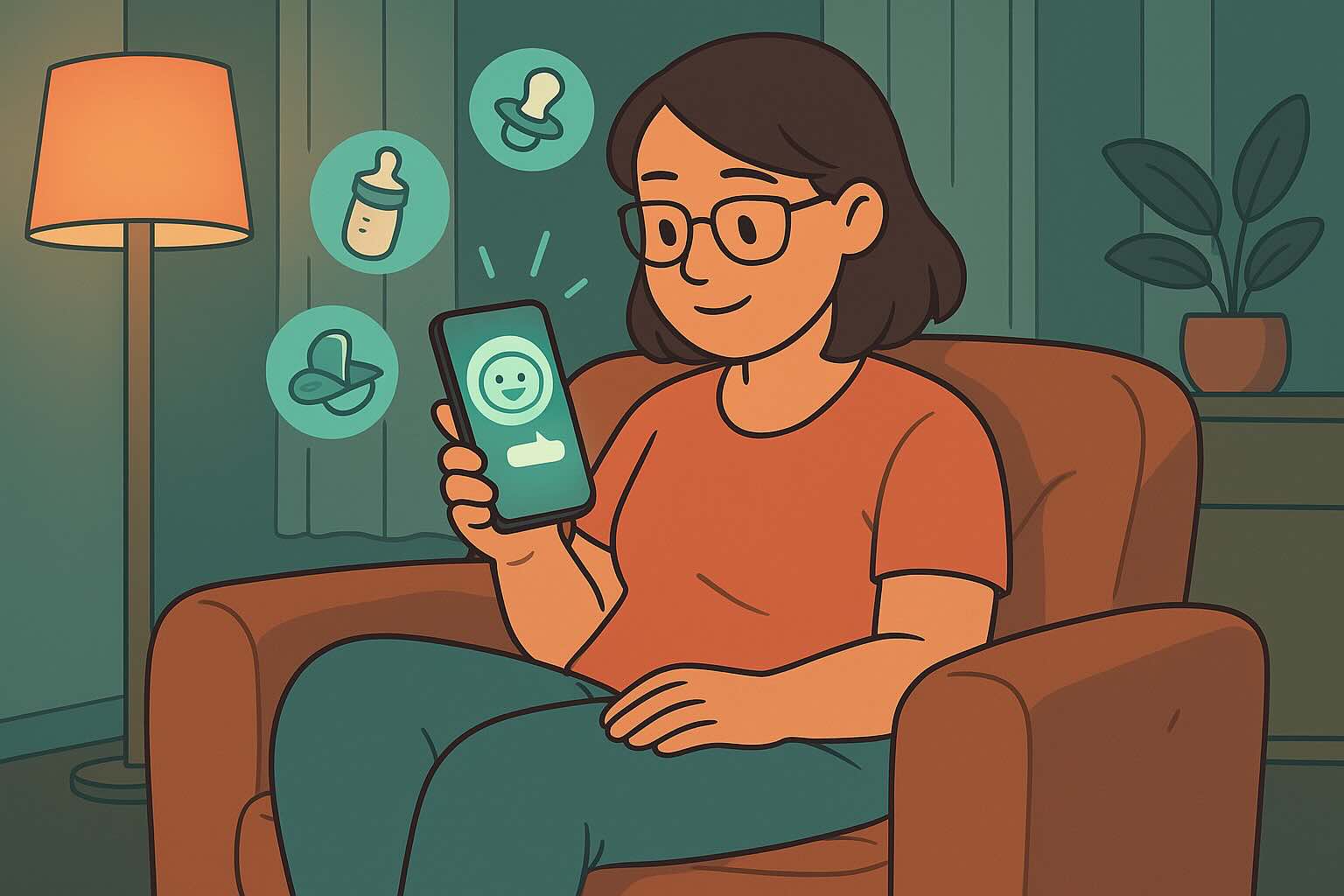
Get Your Free Sleep Training Toolkit
5-day email course + printable sleep log to help your baby sleep through the night
Frequently Asked Questions
Need personalized support?
RootWise's AI coach can provide tailored strategies for your specific situation, available 24/7 when you need it most.
Learn More About AI Coaching →